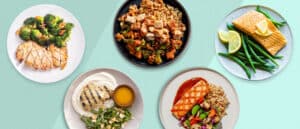Canned Chicken Is Packed With Protein, but It’s Also Processed. Is It Healthy?
- By Sydney Bueckert, NASM C.P.T., C.E.S., F.N.S., G.P.T.S.
- Fact Checked by Jennifer Dutton, NASM-CNC
- April 17, 2024
We’re kind of embarrassed to admit how much we love canned chicken. In our defense it has a lot of good things going for it: High protein, pre-cooked, affordable, and key for whipping up a quick chicken salad. But any meat that can gather dust on your pantry shelf for three to five years and supposedly be fine, is questionable at best. Which brings up some very fair questions. Like, what added ingredients are lurking in canned chicken? And is canned chicken as healthy as fresh chicken? Here’s the scoop.
Is Canned Chicken Healthy?
For the most part, yes. As quick-prep meals go, canned chicken is healthier than most pre-packaged options that tend to be loaded with junk. “Canned chicken is an excellent and convenient source of high-quality protein,” registered dietitian Jessica Levinson, M.S., R.D., C.D.N. explains. A high-protein snack or meal can help you reduce hunger levels, lose weight, boost metabolism, and burn more fat (1, 2, 3). Canned chicken is also rich in vitamins and minerals like zinc and selenium which can boost your immune system, as well as niacin, vitamin B6, and vitamin B12 which play an essential role in energy production (4).
Just keep an eye out for added ingredients. Many canned chicken brands use sodium phosphate to preserve the texture of the chicken. However high levels of serum phosphate have been associated with a higher risk of overall mortality and cardiovascular disease, and might pose a risk for people with chronic kidney disease (5). Most canned chicken is also heat-packed into BPA-lined cans. At present, low levels of BPA in food are safe, according to the U.S. Food and Drug Administration. However, several studies have linked BPA exposure to diabetes, obesity, heart disease, and endocrine disruption (6, 7, 8).
You’ll also want to watch the sodium. “Look for low sodium or no-salt-added canned chicken varieties,” suggests Levinson. Sodium is an important mineral that can help control fluid balance, nerve impulses, and muscle function, but too much sodium is linked to high blood pressure (9). The American Heart Association recommends consuming less than 2,300 mg a day, but a typical serving of canned chicken can rack up to 450 mg in one sitting. And that’s not including the sodium in the mayo and mustard of your mom’s secret chicken salad recipe, or the pickle you *must* have on the side.
About the Expert
Jessica Levinson, M.S., R.D., C.D.N. is a registered dietitian and nationally recognized nutrition expert with a focus on culinary nutrition and communications.
Canned Chicken Nutrition
Canned chicken brands vary significantly in flavor and nutrition profile. For the healthiest canned chicken look for:
- Low sodium
- Fewer added ingredients
- “White Chicken” or “Chicken Breast” on the label
Here’s how the top brands stack up:
|
Brand |
Serving Size |
Calories |
Protein |
Fat |
Sodium |
Ingredients |
|
3 ounces |
90 |
19g |
2.5g |
30mg |
Organic chicken breast with rib meat |
|
|
2 ounces |
60 |
13g |
1g |
210mg |
Chicken breast, water, chicken broth, flavorings, modified food starch, salt, sodium phosphate |
|
|
2 ounces |
45 |
9g |
1g |
80mg |
Chicken breast, water, sodium phosphate |
|
|
2 ounces |
60 |
11g |
2g |
320mg |
White chicken, water, salt, modified food starch, sodium phosphate |
|
|
1 pouch (approx. 2.6 ounces) |
80 |
13g |
2g |
360mg |
White chicken, water, modified food starch, salt, sodium phosphate |
|
|
3 ounces |
60 |
13g |
1g |
380mg |
Chicken breast with rib meat, water, sea salt, modified food starch, sodium phosphate, chicken broth, natural flavors, flavoring |
|
|
3 ounces |
90 |
19g |
2g |
450mg |
Chicken breast with rib meat, water, chicken broth, flavorings, modified food starch, salt, sodium phosphate |
Is Canned Chicken as Healthy as Fresh Chicken?
Probably not. Fresh chicken typically goes straight from a farm to a processing plant (where it’s slaughtered, cleaned and packaged). It takes another stop at the grocery store before making its way into your oven. Canned chicken, on the other hand, is processed and sterilized under high heat to avoid bacteria growth. High heat won’t impact the macronutrient makeup of chicken (i.e. protein, fat, and carbs), but some research suggests it may detract from key vitamins and minerals (10).
For example, check out how a 100 gram (which is about 3.5 ounces) serving of canned chicken compares to the same amount of chicken breast in calories, macronutrients, and micronutrients:
|
Calories |
158 |
185 |
|
Protein |
32g |
25g |
|
Carbs |
0g |
1g |
|
Fat |
3g |
8g |
|
Iron |
3% DV |
7% DV |
|
Selenium |
58% DV |
33% DV |
|
Niacin |
59% DV |
15% DV |
|
Vitamin B6 |
54% DV |
11% DV |
While it might appear that the protein and fat in the chicken changed due to the canning process, this discrepancy is more likely due to the quality of chicken used for the canning. Many canned chicken brands aren’t picky about using only the white meat or chicken breast which contains more protein and less fat than the dark meat found in thighs, drumsticks, and other odd bits.
Unless otherwise specified as “pasture-raised” or “organic” on the label (like Wild Planet), canned chicken brands also typically source their chicken from a factory farm, where chickens are tightly packed into cages and injected with antibiotics so they don’t get sick. Of all the chickens, raised in all the ways, factory farm chickens are by far considered the worst. Animals that live and eat from phytochemically-rich landscapes, like pastures, are healthier. This in turn makes the meat harvested from that animal more nutrient-dense (11).
The big but: Just because canned chicken likely has fewer nutrients than the most expensive, highest quality chicken you can buy doesn’t make it unhealthy. So long as you watch out for sodium and added ingredients, canned chicken is still a solid option for protein in a pinch.













